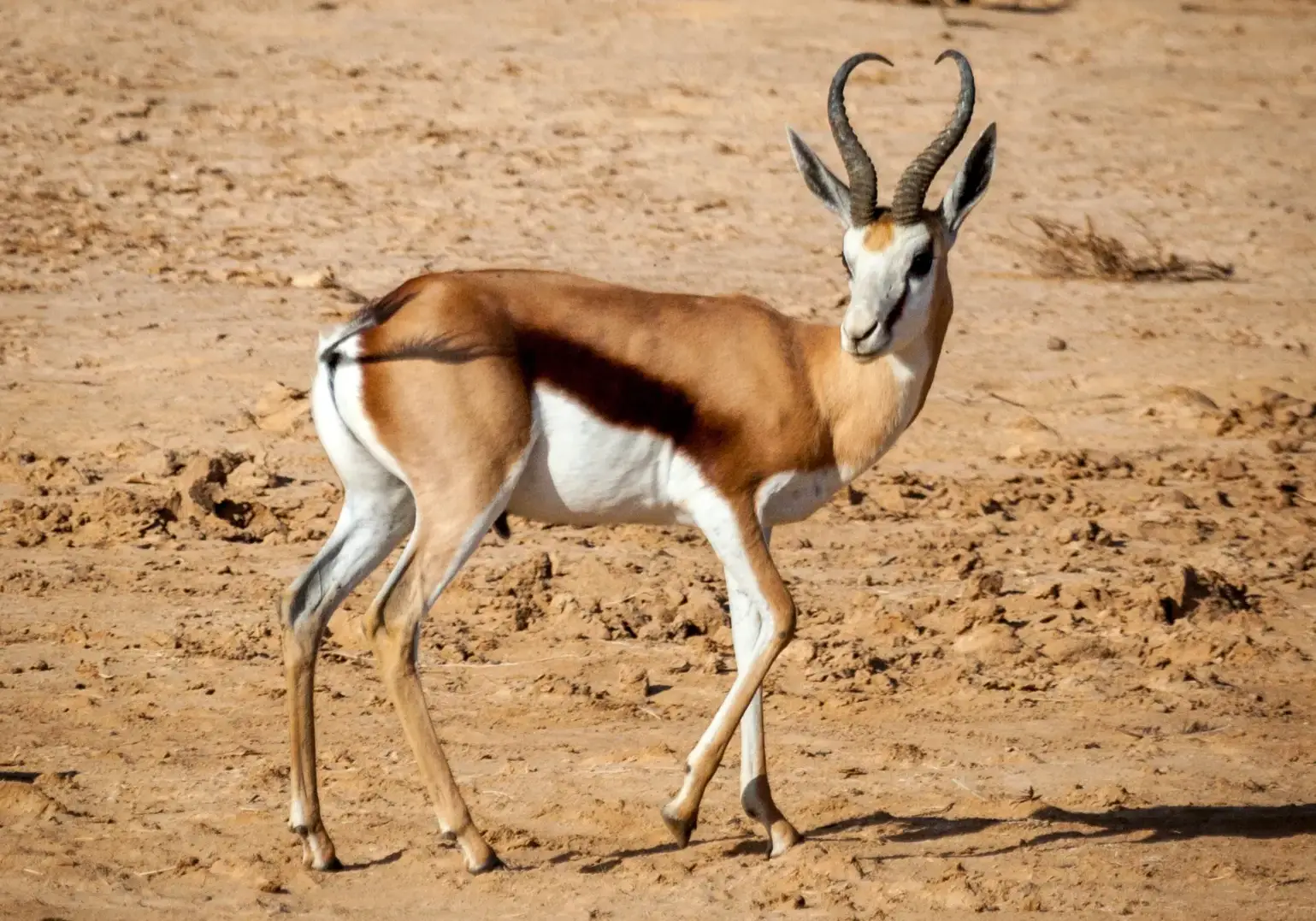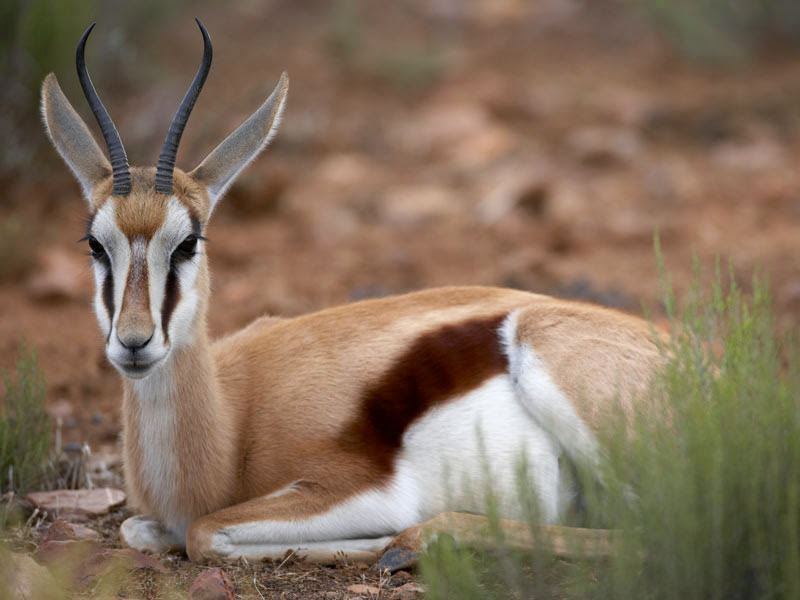The springboks are a sight to behold, especially if you’re watching them run and leap across the veld. Don’t be fooled, we’re talking about the springbok antelope, South Africa’s national animal, not the rugby team. And, if you’re eager to see springboks in Cape Town, look no further than Aquila Private Game Reserve. Located just outside of the city, this Big Five safari and spa offers a chance to see not only springboks but the iconic wildlife and unmatched scenery South Africa is famous for.

The Springbok: Faster than a Lion
The springbok (Antidorcas marsupialis), from the Afrikaans “spring” (jump) and “bok” (antelope), is a small and agile antelope with a distinctive brown and white coat. Standing about 75 cm tall, springboks are known for their leaping behaviour, called pronking. Males weigh up to 50 kg, while females are slightly smaller, reaching around 37 kg.
Once the most abundant antelope in southern and central Africa, migrating across the open plains in their tens of millions, now, according to the IUCN Red List, the total springbok population in south-western and southern Africa is currently around 2,000,000 to 2,500,000 individuals.
Springboks are mainly active in the early hours of the morning and the late hours of the afternoon, at dawn and dusk, but may feed throughout the day during cooler weather, or even at night in the peak of summer, when it’s very hot.
During the warmer months (November through February) springbok sleep and spend most of their time in the shade, under trees or bushes. During the cooler months (May through September), springboks travel further and join larger herds, migrating to find water and food sources, and will sleep or rest out in the open.


Want to see springboks in Cape Town? Here’s what we’ve ‘herd’
Although springboks are more commonly found in the Free State, North West, and Karoo regions, Cape Town visitors can still enjoy sightings of these antelope at Aquila Private Game Reserve. Just two hours outside of the city, Aquila Big 5 Safaris brings you live springbok sightings without having to travel far to see them, making it the perfect option if you’re looking for a day trip adventure or a weekend getaway.
Springbok Herds
Springboks usually live up to 7 or 9 years in the wild, and live in mixed-sex herds comprising of females (sows), young springboks (calves), and a dominant male (ram). Dominant rams help protect the herd. Not only do they keep watch for any threats, but they can fend off smaller predators and signal warnings to the herd. Other male springboks or ‘bachelor males’ often live on the fringes of the herd, and can even form smaller, ‘bachelor groups’ that follow the main herd.
A single calf (baby springbok) is born after a five-to-six-month-long pregnancy (168 day gestation period). Calves can stand, walk and even run within minutes of their birth. Weaning occurs at nearly six months of age, and the calf leaves its mother’s side a few months later. Female offspring will often remain within the mother’s herd for the rest of its life.
Also Read: Meet the Springbok, South Africa’s National Animal

Are Springboks Native to the Western Cape?
Springboks prefer dry grasslands and open savannas, particularly in South Africa’s Western Cape and Northern Cape, but can also be found in vast grasslands of the Free State and the shrublands of the Karoo, where they can survive without direct access to water and endure harsh conditions.
Springboks are native to south-western and southern Africa. Their natural habitat is spread out across a wide range, from South Africa’s Great Karoo, to the Kalahari desert, into Namibia, Botswana, and southern Angola; however, they are confined to the Namib Desert in Angola (north of Namibia).
Some herds are still free roaming, but most large game animals and protected wildlife species are now confined to safari parks, farmlands and reserves. But you can still see springboks in Cape Town, as springboks are a common feature in most of South Africa’s national, provincial and private games reserves — including Aquila Private Game Reserve and Spa.

What Do Springboks Eat?
Springboks are herbivores with a versatile grazing diet. They eat grasses and shrubs, adapting their diet based on availability. In drier seasons, they rely on succulent plants to maintain hydration, which allows them to survive without direct access to water.
What Do Springboks Look Like?
Springboks are easy to recognise with their light brown colouring (tan), white underbelly, and a distinctive dark stripe running down each side, from their forelegs to hindlegs. Both males and females have a pair of black horns (35cm – 50cm), but the rams (males) have thicker, rougher horns than the sows (females). The tips of the springbok’s horns curve inwards at the top, giving them an almost ‘heart-shaped’ or ‘lyre’ shaped appearance.
Springboks stand out with their white heads dark streaks extending from each eye to the corner of the mouth. Their long, pointed ears adds to their interesting appearance. One of their most distinctive traits is a flap of skin along their back, which they can lift to display a fan of white hair. This adaptation helps signal danger to other springboks and is thought to help confuse predators.

Springing Bucks: All About Pronking
One of the most memorable thing about springboks is their ability to leap over two metres into the air, a behaviour that gave them their name. When alarmed, they display a jumping response known as “pronking”, where they leap high into the air—an awe-inspiring sight you might be lucky enough to witness at Aquila Private Game Reserve.
What is Pronking?
Pronking is the term given to the act of jumping (springing, stotting, bouncing, dancing) exhibited by antelope, gazelle, and even goats, when they leap into the air with an arched back and stiff legs, typically as a form of territorial display or flight response when threatened.
What is a Group of Springboks Called?
While locals might joke that a group of springboks is called a “rugby team”, the collective noun for a group is springboks is a “herd”. During winter, these animals travel in smaller groups of 10 to 30 individuals, but in the summer months, they often form larger herds of up to 150 individuals, or more.
What are Natural Predators of Springboks?
Cheetahs, lions, African wild dogs, and leopards are the natural predators of springboks in Southern Africa. However, many smaller carnivores and wild cats, like hyenas, jackals, and caracal, may target young or weakened springboks.
Why are Springboks Important in South African Culture?
The springbok has been a national symbol of South Africa for many years, even before Apartheid, a time of white minority rule in the 20th Century. The emblem of the springbok was famously adopted by the national rugby team, and despite political changes, the team still carries the Springbok name today, a tribute to the unifying role it has played — and continues to play — in modern South African society.
Although many sports teams have shifted to the King Protea symbol (the national flower of South Africa), the Springboks rugby team remains an internationally recognised brand and strong symbol of national pride. It’s also no coincidence that the springbok can be found on various national symbols, including the South African Air Force insignia, the Coat of Arms, and the logo of South African Airways (SAA).

Plan Your Cape Town Safari at Aquila
If you’re wondering, “Where can I see springboks in Cape Town?” Aquila Private Game Reserve is the answer. This family-friendly safari destination offers guided safaris where you can witness these graceful animals in their natural habitat, alongside the Big Five (lion, leopard, elephant, buffalo, and rhino).
So, ready to see the springboks in Cape Town? Book your Aquila Big 5 Safari today!







